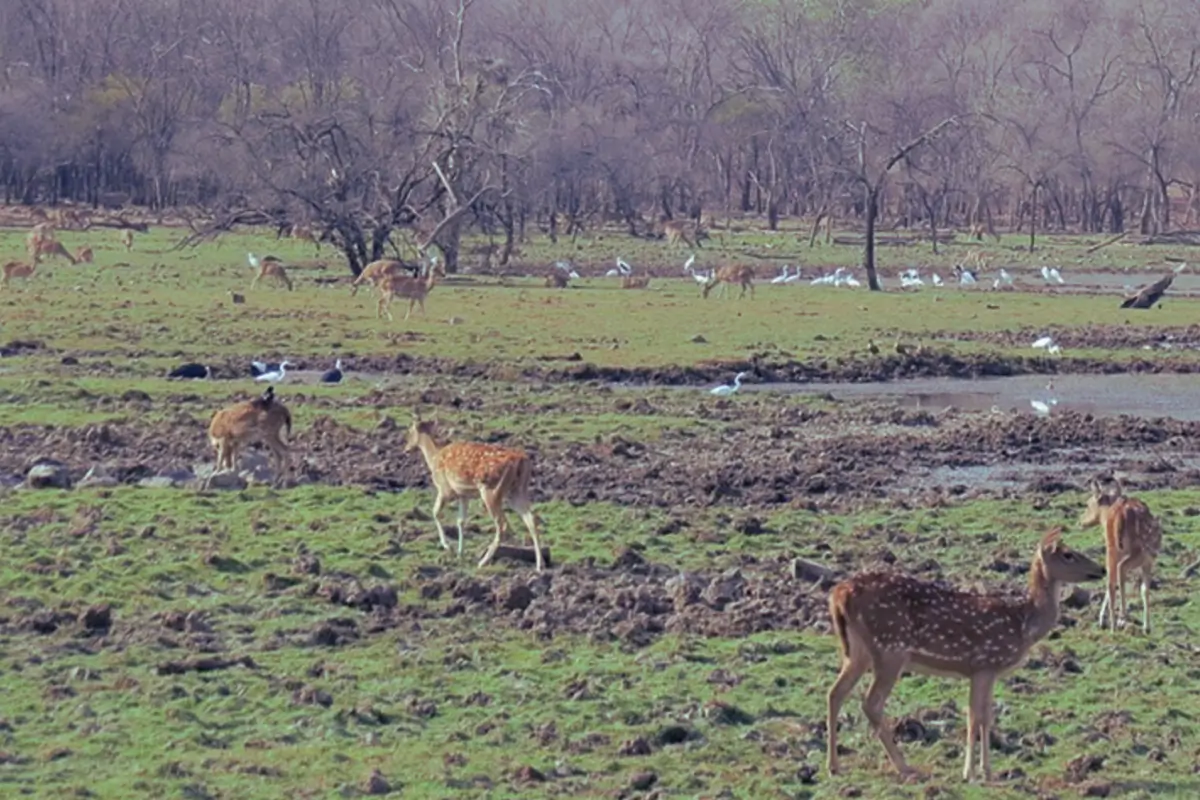India’s Forests Shift Towards Plantations
India’s 2023 forest survey shows a slight rise in forest/tree cover but highlights alarming declines in biodiversity-rich zones and mangroves.

This article by Kundan Pandey originally appeared in Mongabay.
- The Forest Survey of India released its latest India State of Forest Report (ISFR) which shows a marginal increase in forest and tree cover.
- However, there is a decline of forest cover in some biodiversity-rich areas, which experts say is concerning.
- The report highlights an increase in agroforestry and a loss of mangrove cover, particularly in Gujarat and Andaman and Nicobar Islands.
The Forest Survey of India (FSI) has released its 18th India State of Forest Report (ISFR), indicating a marginal increase in India’s forest and tree cover. However, a concerning trend shows a decline in forest cover across several biodiversity-rich areas.
The ISFR, released a year later than scheduled, highlights trends in forest cover change, degradation, agroforestry, carbon sink, mangroves, and forest fires. According to the report, India’s total forest and tree cover is 8,27,357 square kilometres, accounting for 25.17% of the country’s geographical area. This includes 7,15,343 sq. km. (21.76%) of forest cover and 1,12,014 sq. km. (3.41%) of tree cover.
The report claims an increase of 1,446 sq. km. in forest and tree cover since 2021, comprising a forest cover increase of 156 sq. km. (0.2%) and a tree cover increase of 1,289 sq. km. (1.16%). It categorises forest data into recorded forest areas (RFA) which largely consists of the reserved forests and protected forests and non-notified forests. While RFAs show a minor increase of 7.28 sq. km., 20 states and union territories report a decline in RFA category. States like Andhra Pradesh, Arunachal Pradesh, Assam, Chhattisgarh, Madhya Pradesh, Maharashtra, Tamil Nadu, Telangana, and the majority of north-east states have registered negative growth in the recorded forest area. In contrast, non-notified forests have increased by 149 sq. km.
A former Principal Chief Conservator of Forests and Head of Forest Force, Karnataka, BK Singh finds something amiss. He says, “In India, plantation is happening in 18,000 sq. km. annually. But the total forest and tree cover increase is merely 1400 sq. km in two years. It is a total mismatch.” What is happening to the plantations? He asked. “Either the forests are being cut, and plantations are partly supplementing, or a major chunk of plantations are failing. It must be examined.”
Singh says, “Though there are success stories in bits and pieces, the latest ISFR largely creates a disappointing picture.”

Decline in eco-sensitive regions
The ISFR 2023 paints a rosy picture, claiming an overall forest and tree cover increase. However, eco-sensitive zones like the Western Ghats, Himalayan states, and the Andaman & Nicobar Islands have witnessed a decline in forest cover. Over the past decade, the Western Ghats Eco-Sensitive Areas (WGESA) have lost 58.22 sq. km. of forest cover, while the latest assessment shows 327 sq. km. decrease in the northeastern region. Recorded forest areas in the Andaman & Nicobar Islands have also declined.
Debadityo Sinha, a Senior Resident Fellow and Lead of the Climate & Ecosystems team at Vidhi Centre for Legal Policy, says that ISFR 2023 highlights that the prime natural forest and eco-sensitive zone are threatened, and the country is moving towards the planted forest. The report boasts of increased carbon sequestration due to an increase in plantation, but it remains silent on carbon unlocked due to increased deforestation.
The report also provides a glimpse into deforestation trends in last decade from 2011 to 2021, through its tree canopy density classification. Forests are categorised as Very Dense Forest (VDF, ≥70% canopy density), Moderately Dense Forest (MDF, 40–70% canopy density), and Open Forest (OF, 10–40% canopy density). Alarmingly, 46,707 sq. km. of VDF, MDF, and OF have degraded into non-forest areas, while 5,573 sq. km. have turned into scrub. Over the past decade, 40,709 sq. km. of forests have lost density, shifting from VDF and MDF to OF.
Calling it a massive change in the quality of existing forests, Sinha says there is a need for a proper study to understand how much carbon gets unlocked when natural forests are cut. FSI should include this aspect in its biennial report when it shares the increased potential of carbon sink due to an increase in forest and tree cover.
An increase in agroforestry and decline in mangrove cover
The latest forest survey dedicates a chapter on agroforestry, a land use system that integrates trees and shrubs on farmlands and rural landscapes. It claims that 21 states and UTs have shown an increasing trend in tree cover, which indicates that agroforestry is being promoted here.
The report estimates the total tree cover under agroforestry in 2023 at 1,27,590 sq. km., including trees with a Diameter at Breast Height (DBH) of 5 to 10 cm and bamboo. Agroforestry has grown by 20.02% over the past decade, from 2013 to 2023.
The total growing stock (sum of all trees by number or volume) under agroforestry in the country is estimated at 1,291.68 M m3 in 2023, an increase of 286.94 M m3 (28.56 %) since 2013. Maharashtra, Karnataka, Odisha, and Rajasthan have the highest growing stock under agroforestry among states, while Jammu & Kashmir, Andaman & Nicobar, Dadra & Nagar Haveli and Daman & Diu lead among UTs.
Singh underlines an issue related to accuracy by saying that agroforestry is, by and large, tree cover and not forest cover. The tree cover is not included in the satellite imagery assessment. The researchers studied 42,972 sampled plots to estimate the tree cover and extrapolated the findings. So, accuracy is not as high as that of the satellite imagery interpretation, but agroforestry has been growing, and this is a good sign, he said, adding, “So we are unable to hold on to our forest, but we are able to grow agroforestry.”

On the other hand, the report highlights a decrease in mangrove cover. India’s total mangrove cover is 4,991 sq. km., accounting for 0.15% of the country’s geographical area. Very dense mangroves constitute 29.33%, moderately dense mangroves represent 30.07%, and open mangroves comprise 40.60%. Since 2021, mangrove cover has decreased by 7.43 sq. km., with notable declines of 36.39 sq. km. in Gujarat and reductions of 4.65 sq. km. in the Andaman & Nicobar Islands. However, Andhra Pradesh and Maharashtra have seen increases of 13.01 sq. km. and 12.39 sq. km., respectively.
Sinha underscores the importance of studying the reasons behind the decline in Gujarat and the Andaman & Nicobar Islands, as mangroves play a vital role in mitigating climate change and protecting coastal ecosystems.
License
Pandey, Kundan. "Forest Survey reveals India’s shift towards plantations, a threat to natural ecosystems." Mongabay, 27 Dec. 2024. Republished under CC BY-ND 4.0 license.




